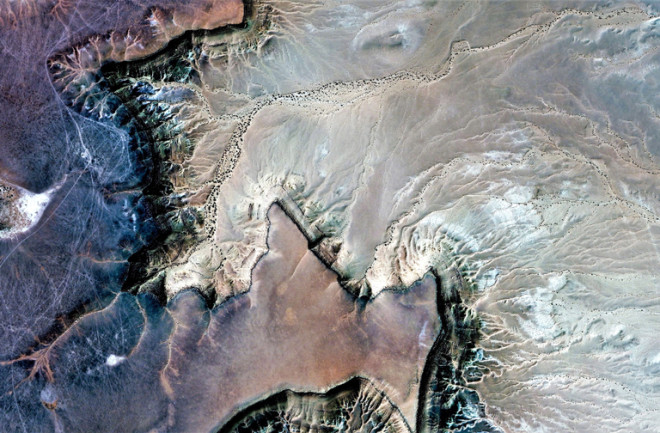Roughly 250 million years ago, Earth’s land masses lay together in one supercontinent known as Pangea. Surrounded by a single ocean, known as Panthalassa, it saw the rise of the dinosaurs.
Pangea was roughly shaped like Pac-Man, with land reaching to both north and south poles and a chunk biting into the middle that contained the Tethys Sea, explains Paul Olsen, a paleontologist at Columbia University. Over the millions of years of its existence, this supercontinent saw the flourishing of biodiversity, bookended by two mass extinctions, he adds.
“During the time of Pangea, you really see this replacement of a kind of archaic land and marine fauna by one that looks much more modern,” says Olsen. “By the end of Pangea, you basically have all the major groups of organisms around.”
Did Dinosaurs Live On Pangea?
Mammals and dinosaurs arrived on the scene during the time of Pangea. Pterosaurs took to the skies, while ichthyosaurs flourished in the oceans. Pangea’s flora may not have been to alien to us in some ways, as it was dominated by species such as conifers, ferns and horsetails, Olsen continues. Flowering plants, however, if present, were very rare.
Though land animals could theoretically walk from one end of this giant landmass to another, Pangea’s geography and variable climate largely dictated where different species and groups dwelled, research shows.
Read More: Dinosaurs Survived Through Freezing Poles Before Jurassic Jungles
Biodiversity of the Pangea Continent
Jessica Whiteside, a professor of geological sciences at San Diego State University, explains that biodiversity was flipped in Pangea compared to today’s world. In our times, the tropics are the hotspot of diversity and polar regions are comparatively sparse, but during Pangean times, the highest diversity was found in the higher latitudes.
“The most interesting thing is that even though you have a supercontinent, you don't have the same lifeforms living all over the place,” says Whiteside. “They're actually very well restricted in these climate envelopes, or climate bands.”
In the Late Triassic for instance, Pangea experienced inordinately high CO2 levels, reaching up to six times higher than today’s current levels. Droughts and wildfires likely ravaged the tropical regions, directly impacting biodiversity in those areas. As a result, these regions were dominated by relatives of crocodiles that didn’t require a reliable source of food.
“In the Pangean world, the tropics had no herbivorous dinosaurs, and only very small carnivorous dinosaurs, and the system was ruled by other reptiles,” Whiteside continues. Those small carnivorous dinosaurs included species such as Coelophysis.
“There was very low diversity in the tropics and this is important for the rise of dinosaurs,” Whiteside explains. “The Triassic was rampant with wildfires, droughts, and rainy seasons, and these low latitudes just couldn’t sustain lush vegetation for large herbivorous dinosaurs to exist.”
Read More: Why Dinosaurs Survived the Late Triassic Mass Extinction
What Was Pangea Like?
Though CO2 in Pangea at this time was high, creating extreme weather conditions and an absence of ice sheets, there was still seasonal freezing of lakes in the high latitudes, Whiteside explains. “Pangea supported seasonal freezing lakes and that's intricately tied to the rise of large herbivorous dinosaurs.”
Researchers believe that one possible reason why dinosaurs came to dominate the world after the end Triassic extinction event — which wiped out much of life on Earth – was due to their adaptation to the cold. Possibly originating in higher southern latitudes by 232 million years ago, it is believed they reached the far North of Pangea before 220 million years ago — meaning dinosaurs adapted to harsh conditions when massive volcanic activity caused cold spells in the late Triassic.
“Dinosaurs actually had hair-like feathers at some point in their life stage and that allowed for them to survive these cold snaps,” Whiteside says. “Whereas crocodile-like creatures well, basically had no insulation, so they died off.”
Read More: Did All Dinosaurs Have Feathers?
When Did Pangea Break Up?
Pangea’s break up began around 195 million years ago in the early Jurassic period. Eventually, this split formed the continents we know today. Much remains to be learned about life on the supercontinent, particularly from the high Arctic and Antarctic regions, according to researchers.
Whiteside says that understanding the development and demise of life on Pangea throughout its existence is of interest not only for natural history, but for Earth’s changing climate today.
“Pangea is one of these time intervals that speaks directly to modern and future warming and how life plays out,” she concludes. “It is a past natural experiment that serves as a partial analogue to future climate change.”
Read More: The Next Pangea: What Earth’s Future Supercontinent Will Look Like

